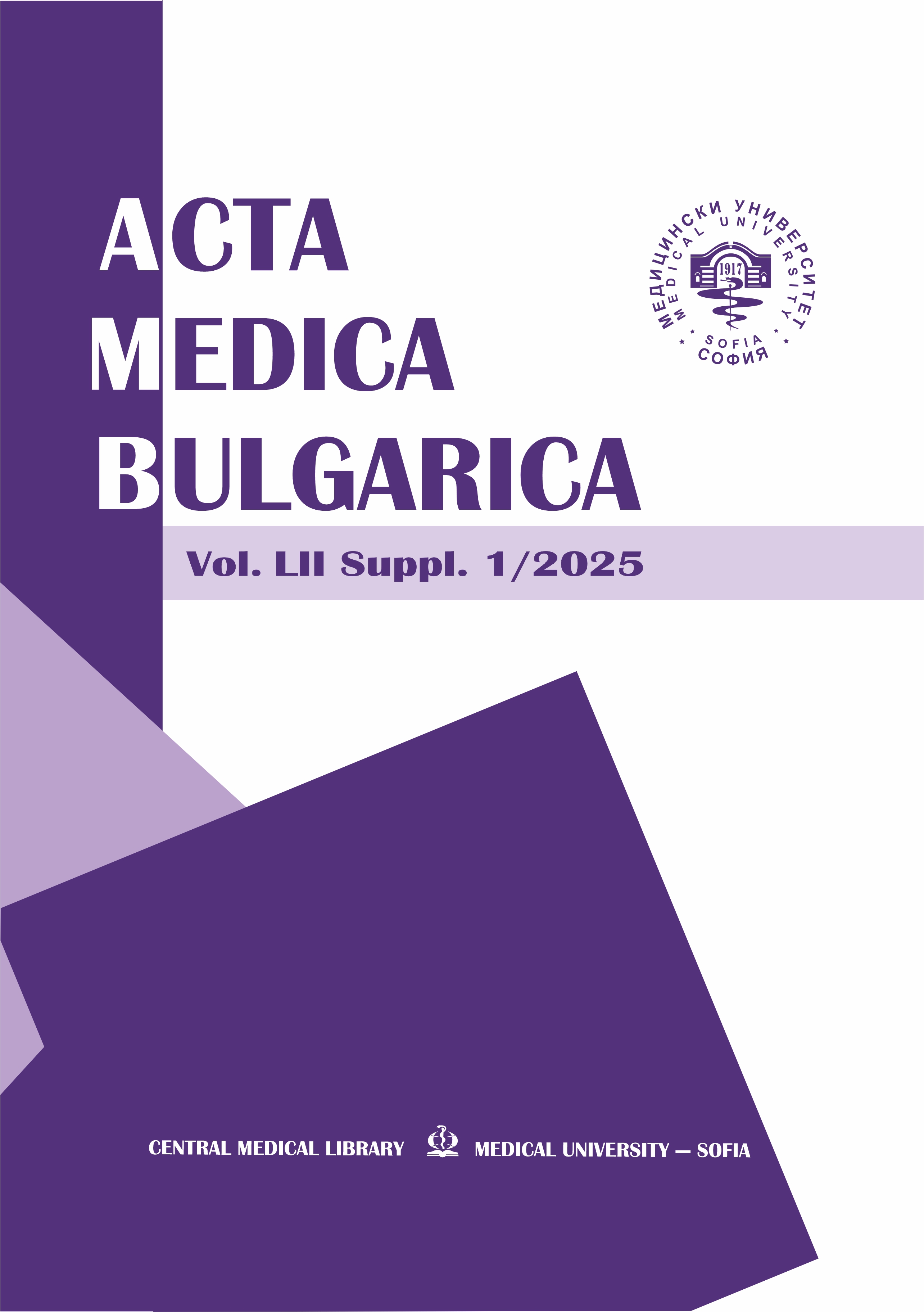Thoracic meningioma presenting with progressive lower paraparesis in a female patient in her 30’s
DOI:
https://doi.org/10.2478/AMB-2025-0019Keywords:
spinal meningiomas, spinal cord, inferior paraparesis, histology of meningiomas, thoracic spinal segment, intradural extramedullary tumors, neurofibromatosisAbstract
The most common tumors located in the thoracic segment of the spinal cord are spinal meningiomas and schwannomas. Meningiomas arising from the sheaths of the spinal cord represent about 20% of all benign tumors of the spinal canal. Second place is occupied by metastases, which mainly aff ect bone structures and much less often – the spinal cord. Meningiomas are predominantly intradural extramedullary tumor formations, although some rare cases of extradural spinal meningiomas have been described in the literature. The World Health Organization divides these tumors into three grades according to their malignancy, which include 15 histological subtypes of meningiomas with a predominantly benign course of development. The psammomatous meningioma belongs to grade I with a benign course and its total extirpation leads to a good ten-year tumor control. Meningiomas are typically slow-growing tumors that commonly present clinically after the fifth decade of life, with a higher prevalence in female patients. The occurrence of thoracic meningiomas in younger individuals, particularly in the second and third decades is often associated with neurofibromatosis. In this report, we describe a female patient in her 30’s with a one-year history of back pain radiating along the ribs, accompanied by progressive lower limb weakness and sensory disturbances over the past 30 days. The clinical complaints and the performed imaging diagnostics show the presence of an intradural, extramedullary tumor formation located at the level of TH5-TH6 vertebral projections and occupying more than 60% of the spinal canal. The treatment consists in total tumor extirpation by means of microneurosurgical technique and histological verifi cation of the process. Subsequent radiotherapy for resected Simpson grade II spinal meningiomas and for psamoma variant of meningioma is not recommended. Clinical monitoring using magnetic resonance imaging is the gold standard for controlling tumor growth.
References
Serratrice N, Lameche I, Attieh C, et al. Spinal meningiomas, from biology to management – A literature review. Front Oncol. 2023 Jan 13; 12:1084404. doi: 10.3389/fonc.2022.1084404.
Sandalcioglu IE, Hunold A, Müller O, et al. Spinal meningiomas: critical review of 131 surgically treated patients. Eur Spine J. 2008 Aug;17(8):1035-41. doi: 10.1007/s00586-008-0685-y.
Näslund O, Lipatnikova A, Dénes A, et al. Meningioma classification by immunohistochemistry: A replicability study. Brain Spine. 2022 Dec 27;3:101711. doi: 10.1016/j.bas.2022.101711.
El-Hajj VG, Pettersson-Segerlind J, Fletcher-Sandersjöö A, et al. Current Knowledge on Spinal Meningiomas-Surgical Treatment, Complications, and Outcomes: A Systematic Review and Meta-Analysis (Part 2). Cancers (Basel). 2022 Dec 16;14(24):6221. doi:10.3390/cancers14246221.
Teranishi Y, Miyawaki S, Nakatochi M, et al. et al. Acta Neuropathol Commun. 2023 Sep 26;11(1):156. doi: 10.1186/s40478-023-01645-3.
Tredway TL, Santiago P, Hrubes MR, et al. Minimally invasive resection of intradural-extramedullary spinal neoplasms. Neurosurgery. 2006 Feb;58(1 Suppl): ONS52-8; discussion ONS52-8. doi: 10.1227/01.neu.0000192661.08192.1c.
Dang DD, Mugge LA, Awan OK, et al. Spinal Meningiomas: A Comprehensive Review and Update on Advancements in Molecular Characterization, Diagnostics, Surgical Approach and Technology, and Alternative Therapies. Cancers (Basel). 2024 Apr 7;16(7):1426. doi: 10.3390/cancers16071426.
Caruso G, Ferrarotto R, Curcio A, et al. Novel Advances in Treatment of Meningiomas: Prognostic and Therapeutic Implications. Cancers (Basel). 2023 Sep 12;15(18):4521. doi:10.3390/cancers15184521.
Elsamadicy AA, Reeves BC, Craft S, et al. A current review of spinal meningiomas: epidemiology, clinical presentation and management. J Neurooncol. 2023 Jan;161(2):395-404. doi:10.1007/s11060-023-04238-1.
Jordan JT, Orr CC, Thalheimer RD, et al. Prospective phase II trial of the dual mTORC1/2 inhibitor vistusertib for progressive or symptomatic meningiomas in persons with neurofibromatosis 2. Neurooncol Adv. 2023 Apr 17;5(1):vdad041. doi:10.1093/noajnl/vdad041.
Bachir S, Shah S, Shapiro S, et al. Neurofibromatosis Type 2 (NF2) and the Implications for Vestibular Schwannoma and Meningioma Pathogenesis. Int J Mol Sci. 2021 Jan 12;22(2):690. doi: 10.3390/ijms22020690.
El-Hajj VG, Pettersson-Segerlind J, Fletcher-Sandersjöö A, et al. Current Knowledge on Spinal Meningiomas – Surgical Treatment, Complications, and Outcomes: A Systematic Review and Meta-Analysis (Part 2). Cancers 2022, 14, 6221. https://doi.org/10.3390/cancers14246221
Voldřich R, Netuka D, Beneš V. Spinal meningiomas: is Simpson grade II resection radical enough? Acta Neurochir (Wien). 2020 Jun;162(6):1401-1408. doi: 10.1007/s00701-020-04280-2.
Lekanne Deprez RH, Bianchi AB, Groen NA, et al. Frequent NF2 gene transcript mutations in sporadic meningiomas and vestibular schwannomas. Am J Hum Genet. 1994 Jun;54(6):1022-9.
Brastianos PK, Twohy EL, Gerstner ER, et al. Alliance A071401: Phase II Trial of Focal Adhesion Kinase Inhibition in Meningiomas With Somatic NF2 Mutations. J Clin Oncol. 2023 Jan 20;41(3):618-628. doi: 10.1200/JCO.21.02371.
Downloads
Published
Issue
Section
License
Copyright (c) 2025 K. Bechev, D. Markov, Galabin Markov (Author)

This work is licensed under a Creative Commons Attribution-NonCommercial-NoDerivatives 4.0 International License.
You are free to share, copy and redistribute the material in any medium or format under these terms.


 Journal Acta Medica Bulgarica
Journal Acta Medica Bulgarica 